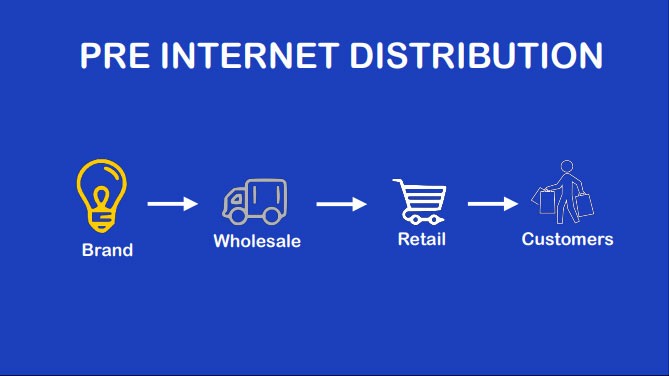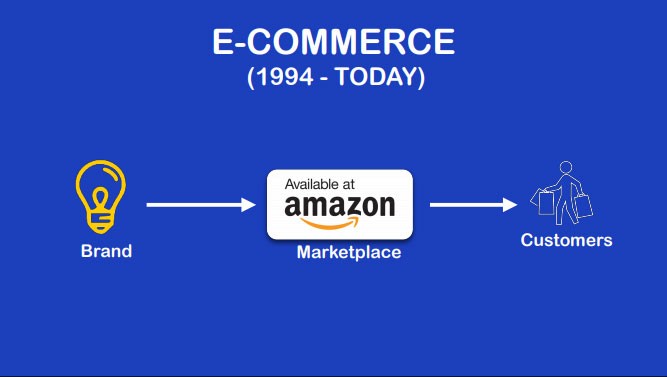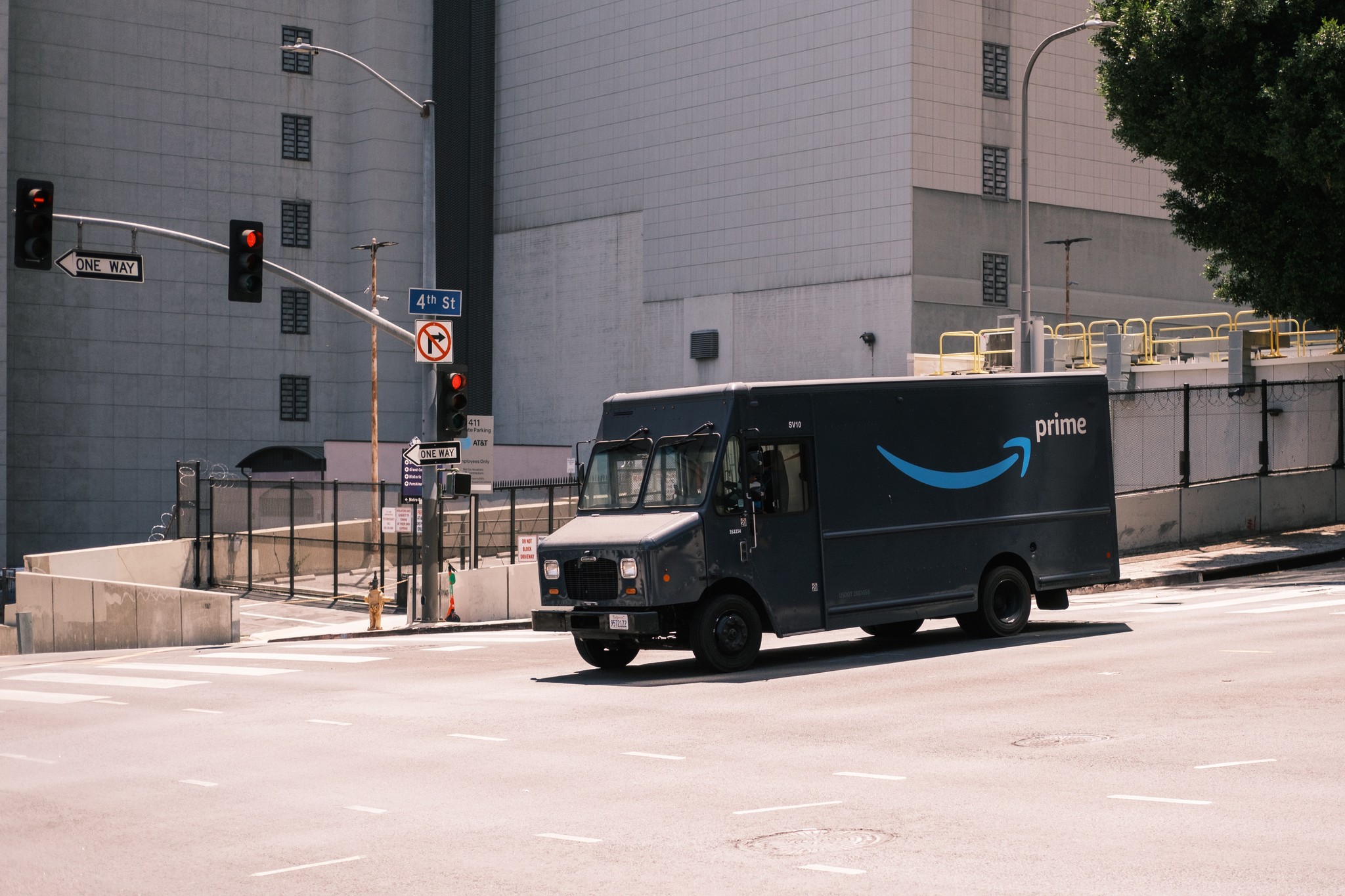Looking back at history you realize that the game changer was always ‘change’ itself. 32 years back Bill Gates was being crowned as the richest man on the earth, at the age of 30 for the PC revolution he came up with. At the time he brought PCs to us, we were feeding a bunch of papers to a machine to process it. Back then they were called as the Mainframes. His innovation revolutionized the world of computers. Fast forward today, Jeff Bezos, the Chairman, CEO and President of Amazon, officially becomes the richest person in the world. In a span of 32 years, internet replaces the PCs as a dominant power.
A vacuum in technology paves way for a new one. Internet replaces PC as the main source of all the computing. It doesn’t matter if you own a desktop PC or not, you have access to everything, everywhere on a plethora of devices. If you want to stay ahead of the game you have to identify the vacuum and adapt accordingly.

pre-internet-distribution
Internet is changing the way we shop today.
We see marts around the world closing all thanks to the shift in customer reach we now see because of the e-commerce boom.
Working with native brands
This is how our retail stores have worked ever since they came into existence. In the pre-internet distribution of products, the sales and marketing is outsourced. As a brand you never really have to sell your product directly to the customer. All you need to do is build one.

e-commerce
But things have changed, or rather, evolved. For any commodity store out there, one of the of the options out there is the Amazon Marketplace. Brands love Amazon for it is easy to get traction, has cheap list building of products, gives access to a large pool of customers with free customer service and support.
5 years back I was selling products on Amazon in full swing until I found out the dark side of selling on Amazon.
THE DARK SIDE OF AMAZON
What many people don’t realize when selling on Amazon is that they are actually renting their customers to you. When you sell you have no direct access to the customer. In exchange of sales made through your products Amazon is building its data set. This dataset they keep building is a data gold mine.
How? If they know what the world is looking for they smartly build products around those needs. Amazon came up with its own Amazon Basics and started competing with businesses already selling on Amazon.
When they found a market full of people looking for premium apparel, you see Amazon Elements surfacing. These are all called Amazon Private Labels and are owned by Amazon itself. But you see where this is powered from?
In digital marketing data is the mass weapon of destruction. Amazon has that and a lot of it.
Selling on Amazon is one of the many options out there, I’ll be sharing with you an alternative today. Something we like to call as a native brand.
NATIVE BRANDS
Native brands are known to be direct-to-consumer brands. More specifically, native brands don’t use any third party sales channel. They design, distribute, market and sell their own products.
WHY NATIVE BRANDS WORK?
Amazon has the advantage of conveniently shipping products to the end customers in the shortest spans of time. This helps them significantly reduce their prices. But they don’t really design low volume products. Why? Because they wait for you guys to come in and sell those products, build data sets for them so they can start building their own once they make sure the buying volumes are huge.

strategy brainstorm
Consumers are craving for niche products; they are willing to pay more for the experience. Customization and personalization are surfacing. The advent of social media and the pervasiveness of smartphones has made all this possible in costs that are low and efficient.
We have many many native brands coming into the picture. For instance, Kylie Jenner’s native brand is closing to around a billion dollars with only 8 people in the company and 100% ownership of their brand.
Movement Watches was just bought by Novarro for $200 Million and this was a 5-10 people running the company from a dorm room.
You just got to look for a loop and take full advantage of it. The technology is there all you have to do it be creative enough.
Top 5 Things To Become A Native Brand
You’ll hear a lot of experienced gurus out there recommending you sell on Amazon but there are endless opportunities out there waiting for you when you go native. What are they and how can you take maximum advantage from them?
1. Start With Insanely Great Products
The first thing you got to keep in mind is to be iterative when producing products. Iterative product development, alpha, beta testing, MVP cycles are all something you want to benefit from. Don’t produce your product in the dark. Remember that constant feedback from your audience is crucial. Run all the available tools, and ads to see what the response is. Take the data to do some research and then market fit your product even before you actually start mass producing it.
Consider the requirements before you go for a warehouse full of product that just doesn’t fulfill the customers’ needs. This is the right time to make amends if your product doesn’t market fit. Keep a lookout for all the feedback data and use it in the next phases of your marketing.
2. Invest In Your Customer’s Journey
A lot of the brands I work with assume that sales are only a one-time operation. A person sees the ad and they buy the product; but that’s not it. The customer today has a lot of mediums they can interact with before they land on your product. The way your customer consumes data is actually very predictable.
So, try to map your customer’s journey and think like a media company. For that you need to become a prolific content creator and have credible people in your team to focus on just that. Test your predictions against your previous data. Most importantly, remember that your customer is the hero, not you. Find their pain and create a story instead of just going on and on about your features.
Your buyer’s journey basically has three phases:
TOFU - Top Of The Funnel
This is where you typically generate leads through social media platform and people get to know who you are. You can do this by awareness campaigns, opt-ins in return of free white papers, guides, e-books or checklists.
MOFU - Middle Of The Funnel
This is where you generate prospects and do that through very specific offers like webinars, case studies, free samples, catalogs, FAQs and more. You don’t really have to come up with a complete site for this phase. A simple page with testimonials and your ads can do.
BOFU - Bottom Of The Funnel
This is where you generate sales via qualified leads. You offer them demos, assessments, consultations, estimates or coupons and make sure you get the client.
This is basically the algorithm to figure out customer’s behavior on your product. This layering of approach works. All this leads to smart ads to specific target people.
3. Create Unique Customer Experience
When you are building a native brand make sure you have a unique customer experience with it. This is one of the most important things to do because by the end of the day your customers do need to feel special.
I’ll tell you what unique is. Recently I was looking into this brand called ‘Glossier’. They have this unique set of attributes that makes them stand out from the crowd. For instance, instead of doing ads they believe in influencer marketing. They have a product demo at the store where you purchase their product and get it delivered to you the very next day.
There store is where you actually really experience the brand. These are personal experiences and get carved into the customer’s mind.
Marcher Studio is a single person brand with custom made products build in USA. It actually takes a month to produce the product. They offer heavy customization in their products. They have the Kickstarters model where you pay first, the product is then custom made for you and you get it delivered to you in 20 days.
You get to visit their soiree where you can touch and feel the product and request for your customizations too. This is something not everyone is doing. Even if they do, you can still do so much to stand out.
4. Smart Advertising
20 years back when I started using ad campaigns I was spending close to 100 thousand dollars in ad-spent for the whole year running the same ad over and over again. This was the time when the internet was new and we had 50% click-through rates. Today if someone gets a 3% click-through rate they feel blessed.
Be contextual when you deliver your ads. Don’t carpet-bomb your customers with the same ads over and over again. People like to see different approaches and that renders better results. Make use of the data you keep gathering and constantly improve based on that.
5. Relationship Commerce
If you are doing a commodity product Amazon is for you but if you are doing a native brand you have to be unique and able to create one-of-a-kind products.
Try and connect with your customers. Make use of underpriced channels like Youtube where cost-per-lead is currently low but these trends keep changing.
Go mobile-first and keep a lookout for new and emerging trends, like chat based commerce and Google Pay, Apple Pay, etc.
Why Native Brand Is Great For Business
For starters, they do not need a lot of capital. If you are creative enough and use the right brand strategy for your native brand you can narrow down your expenses.
Communicate directly with your customers. Do it our way because you have the liberty.
You have it all to yourself. 100%.
Since you have the liberty to do it, you can totally alter your customer’s experience with your brand.
The Takeaway
Take full liberty at being creative.
Anything you see today can totally be redesigned into something better. You can totally improve whatever it is we have today. If someone says, this cannot be done, question that. You can always innovate in this digital era.
Make full use of all the data you collect in the process and make sure you test the product before launching it. As long as you are willing to take risks, you’ll make it.
